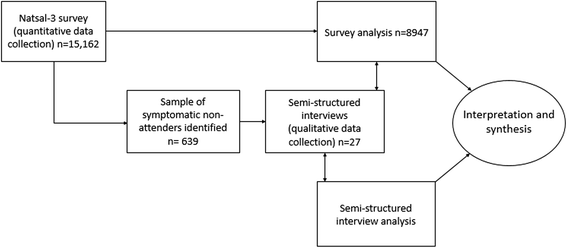How social representations of sexually transmitted infections influence experiences of genito-urinary symptoms and care-seeking in Britain: mixed methods study protocol
- PMID: 27400780
- PMCID: PMC4940703
- DOI: 10.1186/s12889-016-3261-0
How social representations of sexually transmitted infections influence experiences of genito-urinary symptoms and care-seeking in Britain: mixed methods study protocol
Abstract
Background: Social understandings of sexually transmitted infections and associated symptoms and care-seeking behaviour continue to lag behind advancements in biomedical diagnostics and treatment, perpetuating the burden of disease. There is a lack of research linking perceptions, experiences and care-seeking for sexual health issues, especially research conducted outside of medical settings. We aim to explore lay perceptions of STIs and how these influence experiences of genito-urinary symptoms and associated care-seeking behaviour, in women and men in Britain.
Methods and design: This study adopts a participant-selection variant of the explanatory sequential mixed methods design to incorporate quantitative and qualitative strands. We use data from Britain's third National Survey of Sexual Attitudes and Lifestyles (n = 15,162) to analyse national patterns of symptom experience and care-seeking, and to identify a purposive qualitative sample. Semi-structured interviews (n = 27) following up with survey participants include a novel flash card activity providing qualitative data about infection perceptions, symptom experiences and decisions about healthcare. Quantitative and qualitative data are analysed separately using complex survey analyses and principles of Interpretative Phenomenological Analysis respectively. Data are then integrated in a subsequent phase of analysis using matrices to compare, contrast and identify silences from each method.
Discussion: This is an ongoing mixed methods study collecting, analysing and synthesising linked data from a national survey and follow-up semi-structured interviews. It adds explanatory potential to existing national survey data and is likely to inform future surveys about sexual health. Given the current uncertainty around service provision in Britain, this study provides timely data about symptom experiences and care-seeking behaviour which may inform future commissioning of sexual healthcare.
Keywords: Care-seeking behaviour; Genito-urinary symptoms; Mixed methods research; Natsal-3; Non-attendance; Semi-structured interviews; Sexually transmitted disease; Sexually transmitted infections; Survey.
Figures
Similar articles
-
Understanding sexual healthcare seeking behaviour: why a broader research perspective is needed.BMC Health Serv Res. 2017 Jul 6;17(1):462. doi: 10.1186/s12913-017-2420-z. BMC Health Serv Res. 2017. PMID: 28683744 Free PMC article.
-
Help-seeking for genitourinary symptoms: a mixed methods study from Britain's Third National Survey of Sexual Attitudes and Lifestyles (Natsal-3).BMJ Open. 2019 Oct 30;9(10):e030612. doi: 10.1136/bmjopen-2019-030612. BMJ Open. 2019. PMID: 31666264 Free PMC article.
-
Sexually transmitted disease among street dwellers in southern Ethiopia: a mixed methods study design.BMC Public Health. 2020 Apr 3;20(1):434. doi: 10.1186/s12889-020-08584-x. BMC Public Health. 2020. PMID: 32245375 Free PMC article.
-
Prevalence, risk factors, and uptake of interventions for sexually transmitted infections in Britain: findings from the National Surveys of Sexual Attitudes and Lifestyles (Natsal).Lancet. 2013 Nov 30;382(9907):1795-806. doi: 10.1016/S0140-6736(13)61947-9. Epub 2013 Nov 26. Lancet. 2013. PMID: 24286785 Free PMC article.
-
Female transactional sex workers' experiences and health-seeking behaviour in low-middle income countries: a scoping review.BMC Public Health. 2024 Oct 9;24(1):2749. doi: 10.1186/s12889-024-20211-7. BMC Public Health. 2024. PMID: 39385113 Free PMC article.
Cited by
-
Understanding sexual healthcare seeking behaviour: why a broader research perspective is needed.BMC Health Serv Res. 2017 Jul 6;17(1):462. doi: 10.1186/s12913-017-2420-z. BMC Health Serv Res. 2017. PMID: 28683744 Free PMC article.
-
The effect of sexuality education based on the information, motivation, and behavioral skills model on improving the teachers' professional competence.Heliyon. 2024 Jan 7;10(2):e24170. doi: 10.1016/j.heliyon.2024.e24170. eCollection 2024 Jan 30. Heliyon. 2024. PMID: 38293482 Free PMC article.
-
PRIME (Positive Transitions Through the Menopause) Study: a protocol for a mixed-methods study investigating the impact of the menopause on the health and well-being of women living with HIV in England.BMJ Open. 2019 Jun 5;9(6):e025497. doi: 10.1136/bmjopen-2018-025497. BMJ Open. 2019. PMID: 31171548 Free PMC article.
-
Help-seeking for genitourinary symptoms: a mixed methods study from Britain's Third National Survey of Sexual Attitudes and Lifestyles (Natsal-3).BMJ Open. 2019 Oct 30;9(10):e030612. doi: 10.1136/bmjopen-2019-030612. BMJ Open. 2019. PMID: 31666264 Free PMC article.
References
-
- Public Health England. Sexually transmitted infections and chlamydia screening in England, 2013: Infection report. London; 2014.
MeSH terms
Grants and funding
LinkOut - more resources
Full Text Sources
Other Literature Sources
Medical



